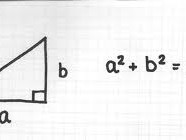NFL Pythagorean Expectation
In the 1980s, sports analytics pioneer Bill James developed a formula to calculate an expected winning percentage for a MLB team based on its’ runs scored and runs allowed. The equation, named after its resemblance to trigonometry’s Pythagorean Theorem, is fairly simple:
Written by Justin Zovas (follow him on twitter @JustinZovas)
The formula computes how many games a team should have won based on its runs scored and allowed. James found that a team’s scoring margin is highly correlated with its winning percentage. Teams whose actual wins exceeded their Pythagorean wins are considered ‘lucky’ and teams that underperformed relative to their Pythagorean expectation are considered ‘unlucky’. For those of us concerned with predicting future outcomes, the main takeaway is that Pythagorean win percentage is superior to actual winning percentage in determining a team’s future winning percentage.
Over the years, the formula has been slightly altered by statisticians and refined for NFL analysis (2.37 is the exponent commonly used for football). Although the sample size is dramatically reduced, evidence supports that NFL teams that overachieve or underachieve relative to their expected Pythagorean win expectation are subject to regression the following season.
Inspired by Joe Peta’s work with “Cluster Luck” in baseball as described in his book Trading Bases: A Story About Wall Street, Gambling, and Baseball, I have taken this type of analysis a step further and created a second-order Pythagorean win expectation for NFL teams. My goal is to answer the following question: Based on a team’s performance statistics, what should have been its net scoring differential and then, ultimately, its ‘adjusted’ Pythagorean win percentage?
The reasoning is that the influence of randomness is not limited to just wins and losses. A number of bounces—of both good and bad fortune—over the course of a season can result in a team’s scoring margin deviating from its true talent level. With this in mind, my aim is to develop an improved method to eliminate a season’s worth of randomness and perform a better retrodictive evaluation of NFL teams from season to season.
I ran a multivariable regression (using data from the past 5 seasons) and found that two key metrics—yards per play and yards per point—are very strong predictors of a team’s scoring differential. In fact, the correlation between net scoring differential versus yards/play and yards/point (.953) is stronger than the correlation between wins versus net scoring differential (.917).
By now, most NFL junkies are well aware of the concise, yet powerful metric of yards/play. However, yards/point is a stat that remains somewhat underrated. The five-year average of the entire league’s yards/point for is 15.76. In other words, on average, NFL teams gain 15.76 yards for every point they score. Yards/point picks up the story where yards/play lets off; it gives an indication of a team’s red zone efficiency and to what degree it has benefited from good field position via turnovers or special teams play. When regressed together, the two metrics combine to be great predictor of a team’s points for and points allowed.
With this new regression equation I computed an ‘adjusted’ points for and points allowed as a function of a team’s yards/play and yards/point metrics. For example, let’s examine the 2012 Miami Dolphins who finished with a 7-9 record. The Dolphins scored 288 points and surrendered 317 which was good for a Pythagorean expectation of 7.09 wins. In other words, the Dolphins actual win/loss record was right on par with what would be expect based on their scoring differential. Looking at the 2nd derivative, however, the Dolphins key stats tell a different story. The team earned marks of 5.1 yards/play for versus 5.3 yards/play against and posted a 17.3 yards/point for versus 18 yards/point against. Putting these numbers in the equation, the Dolphins ‘adjusted’ points for was 306.12 and just 293.18 points against indicating that the team should have won roughly 8.41 games. On the surface it may appear that the Dolphins games played out as they should have, but at closer look there is evidence that they experienced some degree of bad luck in 2012.
Anyone can create an elaborate formula, but studying past results is the only way to validate the strength of this second-order Pythagorean win computation. We should expect to see the records of teams that overachieve or underachieve relative to their adjusted Pythagorean expectation to regress towards their true ability the following year. Below is a chart showing on average how these lucky and unlucky teams performed the following season.
| Adjusted Wins – Actual Wins | Average change in wins the following season |
|
-2 or less |
Declined by 1.48 wins |
|
-1 to -2 |
Declined by 2.4 wins |
|
1 to 2 |
Improved by 2.9 wins |
|
2 or more |
Improved by 2.6 wins |
For example, the 2011 Kansas City Chiefs won 7 games despite their performance statistics indicating they only should have won 2.69 games. In 2012, the Chiefs reverted more towards their true ability winning just 2 games. Many bettors were bullish on the Chiefs heading into 2012 (season win total was o/u 8 wins), but if they were better aware of their 2011 good fortune it could have caused some to reconsider.
Of the 63 teams in the previous four years that overachieved or underachieved by more than one full game relative to their adjusted win expectation, 52 of those teams reverted to at least one game towards their true level of performance that following season.
Check out next week’s column where I will review last season, revealing some of the most over and underachieving teams and try to identify some betting value headed into 2013.













